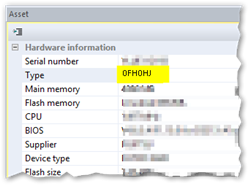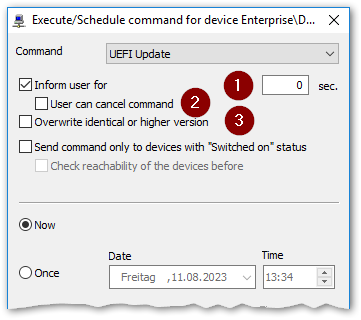Configuring UEFI updates
The UEFI firmware archives need to be mapped to the relevant device types. This is done in a dedicated UEFI file which then is specified in the device configuration of all devices that are supposed to receive UEFI updates.
-
For all relevant device types, identify the type name. For a selected device, look up the Type name in the Scout Console, in the Asset window under Type.

-
As a UEFI file, create a text file with the following:
-
File name extension *.udf
-
Any file name
For each model type, insert a line with <type>=<firmware archive>
Example: 0FH0HJ=Dell_Latitude_3330_1130.cab1

If you have the UEFI firmware in a dedicated container, specify each model type with <type>=<path/firmware archive>
Example: 0FH0HJ=../UC_UEFI/dell_latitude_3330/Dell_Latitude_3330_1130.cab2
-
-
Import your UEFI file (*.udf) into your eLux container on the web server.
-
To modify the device configuration, for the relevant devices, open Device configuration > Firmware.
Under UEFI file, enter the name of your *.udf file with the file extension.

1 UEFI file in the eLux container 2 From the specified data, the system generates a URL that is used by the devices to update their UEFI. 3 Users may postpone a UEFI update just like a firmware update if configured under Reminders. For further information, see Update deferment by users in the Scout guide.
The UEFI file is located on your web server in the eLux container. In the device configuration of the relevant devices, the UEFI file is referenced.
UEFI files can be globally predefined by the administrator just like image files. For further information, see Predefined images and containers in the Scout guide.

